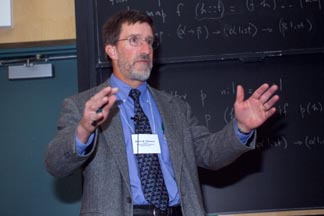Celebrating four decades, materials science department looks back and forward
By Lauren Gold

When it all started, there were slide rules and sketchy switchboard-operated phone lines. But there was also the eager energy of a cluster of physicists, chemists and engineers who snagged a round table at the Rathskeller nearly every day and talked about the future of their fields.
That was 1965. Now, the slide rules and party phone lines of 1965 have been replaced by supercomputers and tiny cell phones. Even the Rathskeller is history. Charlie Tracy, adjunct professor in the Department of Materials Science and Engineering (and a Cornell student 40 years ago), listed a few of these changes in his talk at a Sept. 20 symposium marking the department's 40th anniversary.
He was happiest to mention the things that haven't changed: The department's high standards; its position in the top ranks of materials science departments in the world; and mostly, that energy, equally as contagious today as it was in 1965.
Tracy was one of two dozen speakers at the symposium -- a day featuring university faculty and industry leaders addressing the symposium's theme: Materials Science and Engineering in 2020. The event was sponsored in part by the Kavli Institute for Nanoscale Science at Cornell and Panasonic Corp.
For a chemistry or physics department, noted Bruce Clemens, former chair of Stanford University's Department of Materials Science and Engineering, 40 years might not seem like much. But materials science as a distinct discipline is relatively young.
"You don't have 200-year-old materials science departments like you do have 200-year-old chemistry departments," said Clemens. Instead, he said, materials science was once scattered among fields of metallurgy, mechanics and physics. Today, the shift continues, but now to blends of chemistry, biology, physics and nanoscience, he said. "The challenge is to increase the breadth of [materials science]," he said, "without decreasing the depth."
In that vein, Cornell is in the process of implementing a strategic plan for the materials science department. Director Emmanuel Giannelis said the plan includes the recently completed laboratory space in the Bard Hall subbasement, overall renovations to Bard and new courses focusing on energy, on biomaterials and information technology, and on technology and ethics.
"We are not only celebrating 40 years of excellence in materials science and engineering, but also the exciting possibility for future innovation," he said. "The common denominator between the early days and today is excellence in education and research."
This year, the department graduated its largest class of undergraduates and was ranked No. 3 nationwide, according to the National Research Council.
"The field of materials science changed forever the landscape and established the forward-thinking interdisciplinary research that has become a trademark in our department," said Giannelis. "That tradition continues today."
Media Contact
Get Cornell news delivered right to your inbox.
Subscribe